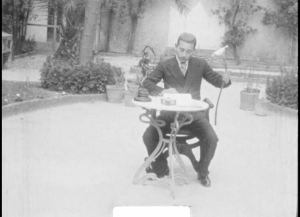
Paradoy of the avantgarde film culture of the era, including references to Salvador Dalí, Luis Buñuel, Joan Miró and dancer Àurea de Sarrà. It is interesting because it shows the crossed dialogue between these different film cultures that functioned beyond the realm of commercial cinema.
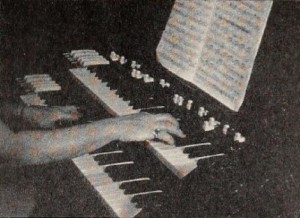
"At the outset of amateur movies' newest medium, magnetic sound on film, Robert G. Williams has accomplished a tour de force with his uncannily perfect synchrony of music to pictures in Poet and Peasant. As Kathryn Williams plays the familiar overture on the Hammond organ, the sound accompaniment matches the hand movements on screen without faltering and without once resorting to tricks or short cuts. Countless closeups of the organist's hands as they play give evidence of Mr. Williams's confidence and ability in the new field. But Mr. Williams also has made a lively and interesting picture from a subject usually so dull and static that, more often than not, it has stumped most professionals. Pacing his film with precision, he has used an amazing variety of camera angles, even shooting from above and behind the organ. Mrs. Williams's playing is competent and assured; but it is Mr. Williams's unusually good filming and recording techniques which bring her abilities vividly to life on screen." Movie Makers, Dec. 1952, 339.
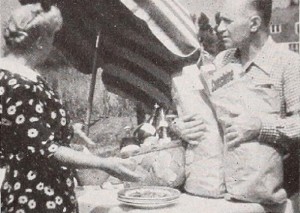
"George Mesaros, who has demonstrated his competence as a maker of good movies in other fields, turns to humor in this film comment on wartime conditions. The point of the story — for it is the foray and not the tale that is pointless — turns on providing for a picnic in the yard of the home. While the master of the house is shopping with ration points, the skeptical family gets, from the Victory garden, cooks and eats the alfresco feast, at the end of which Father — who really did find something in the shops — returns with loaded arms. First class Kodachrome pictures and a well knit continuity are used by Mr. Mesaros to bring to American audiences something of the spirit of easy and natural outdoor fun with food that for so long characterized the Europe of happy memory. Some of the scenes of cooking are so realistic that one almost reaches for what is shown on the screen." Movie Makers, Dec. 1943, 478.
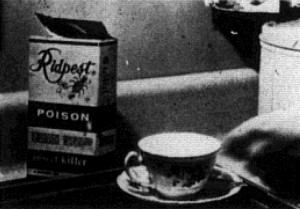
"The dutiful husband gets his own breakfast while his wife enjoys the luxury of sleeping late in the morning. He leaves her breakfast near the bed and we leave him for business. He becomes disturbed over the thought of a possible error in her food serving and feels the need to communicate her immediately. A nice gentle suspense builder" PSA Journal, Oct. 1961, 47.
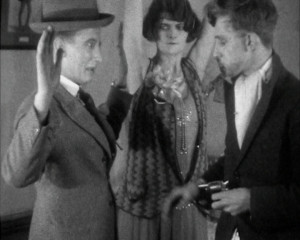
"A man entertains a married woman in her own home. He has previously stolen money from her husband’s wallet and hides the money in a book. The woman in turn removes the money from the book and keeps it for herself. The husband discovers their dalliance and orders the man to go. The man returns and accuses the couple of stealing his money. A burglar interrupts the proceedings. The burglar searches the pockets of the husband and removes (what looks like) another woman’s handkerchief. The burglar then searches the pockets of the man and the wife, discovering the money. The burglar offers the money to the husband in order to recompense him for embarrassing him in front of his wife and proceeds to steal other items from the room, leaving his revolver on the floor. The burglar says farewell. The husband and the man square up to each other" (EAFA Database).
"This film was specifically produced for a meeting of the London Amateur Cinematographers’ Association on 27 March 1929. The film was the basis of a competition for the club members. The club’s members in this case were invited to record the mistakes incorporated into the film. The report in Amateur Films notes that the competition was won by Mrs Nora Pfeil, who recorded approximately 30 mistakes" (EAFA Database).
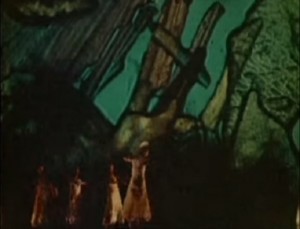
"Dancers move in front of a background made up of crystal formations filmed through a microscope. One of Norman McLaren’s first experimental films." Library and Archives Canada.
Edited film "chronicling travel through Tahiti and Mo'orea including scenic landscapes, aerial views, harbor scenes, resorts, local flora, markets, underwater scenes, dance and storytelling," Human Studies Film Archives, Smithsonian Museum.
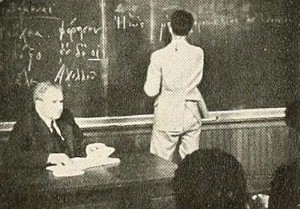
"The title of Pomfret Today, produced by the T. W. Willard Motion Picture Company, gives a clear impression of the subject matter of this recent addition to the Willard tradition of fine school films. Produced for the Pomfret School, in Connecticut, the picture provides a pleasant portrait of a gracious institution carrying on its work amid settings of quiet beauty. Studies, sports, hobbies and recreation — all are recalled here in sequences marked by a wealth of warm color and distinguished technical ability. A directly planned continuity is neatly edited and adequately titled, in a subject designed primarily for alumni screening." Movie Makers, Dec. 1937, 630.
"In the pond, many things are stirring - freshwater earthworms, and tiny aquatic creatures known as infusoria and daphnia. This remarkable amateur scientific documentary investigates microbes in a drop of pond water as seen through a microscope. The film was made by using a binocular eyepiece developed specifically for the purpose, and won many awards." (BFI Player)
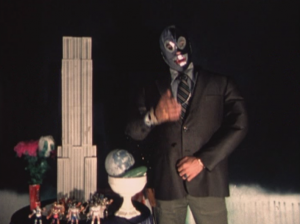
"Siete cortometrajes de Maris Bustamante y Rubén Valencia, integrantes del No Grupo, que indican el acercamiento de artistas plásticos al formato súper 8. Los trabajos del No-Grupo tendieron a hacer una reflexión a la vez lúdica y crítica sobre la naturaleza del arte" Superocheros.
"Seven short films made by Maris Bustamante and Rubén Valencia, members of the No Group, that indicate the interest of artists in the plastic arts to use the super 8 format. The works of the No Group were usually a playful and critical reflexion on the nature of art" Superocheros.
Total Pages: 203